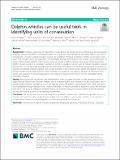Files in this item
Dolphin whistles can be useful tools in identifying units of conservation
Item metadata
| dc.contributor.author | Papale, Elena B. | |
| dc.contributor.author | Azzolin, Marta A. | |
| dc.contributor.author | Cascão, Irma | |
| dc.contributor.author | Gannier, Alexandre | |
| dc.contributor.author | Lammers, Marc O. | |
| dc.contributor.author | Martin, Vidal M. | |
| dc.contributor.author | Oswald, Julie N. | |
| dc.contributor.author | Perez-Gil, Monica | |
| dc.contributor.author | Prieto, Rui | |
| dc.contributor.author | Silva, Mónica A. | |
| dc.contributor.author | Torri, Marco | |
| dc.contributor.author | Giacoma, Cristina | |
| dc.date.accessioned | 2021-08-02T15:30:05Z | |
| dc.date.available | 2021-08-02T15:30:05Z | |
| dc.date.issued | 2021-07-29 | |
| dc.identifier | 275294883 | |
| dc.identifier | a6e29851-90be-4076-b19c-7ee3e28ca4ed | |
| dc.identifier | 85111549779 | |
| dc.identifier | 000679428900001 | |
| dc.identifier.citation | Papale , E B , Azzolin , M A , Cascão , I , Gannier , A , Lammers , M O , Martin , V M , Oswald , J N , Perez-Gil , M , Prieto , R , Silva , M A , Torri , M & Giacoma , C 2021 , ' Dolphin whistles can be useful tools in identifying units of conservation ' , BMC Zoology , vol. 6 , 22 . https://doi.org/10.1186/s40850-021-00085-7 | en |
| dc.identifier.issn | 2056-3132 | |
| dc.identifier.other | RIS: urn:EE3F9CBACB42E6C8CE65BE0F753EE5E9 | |
| dc.identifier.other | RIS: Papale2021 | |
| dc.identifier.other | ORCID: /0000-0002-1524-9592/work/98197241 | |
| dc.identifier.uri | https://hdl.handle.net/10023/23699 | |
| dc.description | Data collection and processing in the Azores was funded by Fundação para a Ciência e a Tecnologia (FCT) and Fundo Regional da Ciência e Tecnologia (FRCT), through research projects TRACE-PTDC/MAR/74071/2006 and MAPCET-M2.1.2/F/012/2011 (FEDER, the Competitiveness Factors Operational (COMPETE), QREN European Social Fund, and Pro convergencia Açores/EU Program). We also thank FCT for supporting MARE (UID/MAR/04292/2019) and OKEANOS (UIB/05634/2020), as well as for the research grants awarded to PR (SFRH/BPD/108007/2015) and CI (Project Awareness - PTDC/BIA-BMA/30514/2017). SMA is supported through project SUMMER (H2020-EU.3.2.3.1, GA 817806). Data collection by SECAC was funded by the EU LIFE programme—project LIFE INDEMARES (LIFE 07/NAT/E/000732)— and the Fundación Biodiversidad under the Spanish Ministry of Environment, Rural and Marine Affairs (project ZEC-TURSIOPS). EP was supported by a LLP/Erasmus grant 2010–2011 for collecting data in the Canary Islands. | en |
| dc.description.abstract | Background: Prioritizing groupings of organisms or ‘units’ below the species level is a critical issue for conservation purposes. Several techniques encompassing different time-frames, from genetics to ecological markers, have been considered to evaluate existing biological diversity at a sufficient temporal resolution to define conservation units. Given that acoustic signals are expressions of phenotypic diversity, their analysis may provide crucial information on current differentiation patterns within species. Here, we tested whether differences previously delineated within dolphin species based on i) geographic isolation, ii) genetics regardless isolation, and iii) habitat, regardless isolation and genetics, can be detected through acoustic monitoring. Recordings collected from 104 acoustic encounters of Stenella coeruleoalba, Delphinus delphis and Tursiops truncatus in the Azores, Canary Islands, the Alboran Sea and the Western Mediterranean basin between 1996 and 2012 were analyzed. The acoustic structure of communication signals was evaluated by analyzing parameters of whistles in relation to the known genetic and habitat-driven population structure. Results: Recordings from the Atlantic and Mediterranean were accurately assigned to their respective basins of origin through Discriminant Function Analysis, with a minimum 83.8% and a maximum 93.8% classification rate. A parallel pattern between divergence in acoustic features and in the genetic and ecological traits within the basins was highlighted through Random Forest analysis. Although it is not yet possible to establish a causal link between each driver and acoustic differences between basins, we showed that signal variation reflects fine-scale diversity and may be used as a proxy for recognizing discrete units. Conclusion: We recommend that acoustic analysis be included in assessments of delphinid population structure, together with genetics and ecological tracer analysis. This cost-efficient non-invasive method can be applied to uncover distinctiveness and local adaptation in other wide-ranging marine species. | |
| dc.format.extent | 13 | |
| dc.format.extent | 3123105 | |
| dc.language.iso | eng | |
| dc.relation.ispartof | BMC Zoology | en |
| dc.subject | Communication signals | en |
| dc.subject | Acoustic divergence | en |
| dc.subject | Geographic variability | en |
| dc.subject | Phenotypic diversity | en |
| dc.subject | Cetaceans | en |
| dc.subject | GC Oceanography | en |
| dc.subject | QH301 Biology | en |
| dc.subject | QL Zoology | en |
| dc.subject | 3rd-DAS | en |
| dc.subject.lcc | GC | en |
| dc.subject.lcc | QH301 | en |
| dc.subject.lcc | QL | en |
| dc.title | Dolphin whistles can be useful tools in identifying units of conservation | en |
| dc.type | Journal article | en |
| dc.contributor.institution | University of St Andrews. School of Biology | en |
| dc.contributor.institution | University of St Andrews. Scottish Oceans Institute | en |
| dc.contributor.institution | University of St Andrews. Sea Mammal Research Unit | en |
| dc.identifier.doi | 10.1186/s40850-021-00085-7 | |
| dc.description.status | Peer reviewed | en |
This item appears in the following Collection(s)
Items in the St Andrews Research Repository are protected by copyright, with all rights reserved, unless otherwise indicated.

